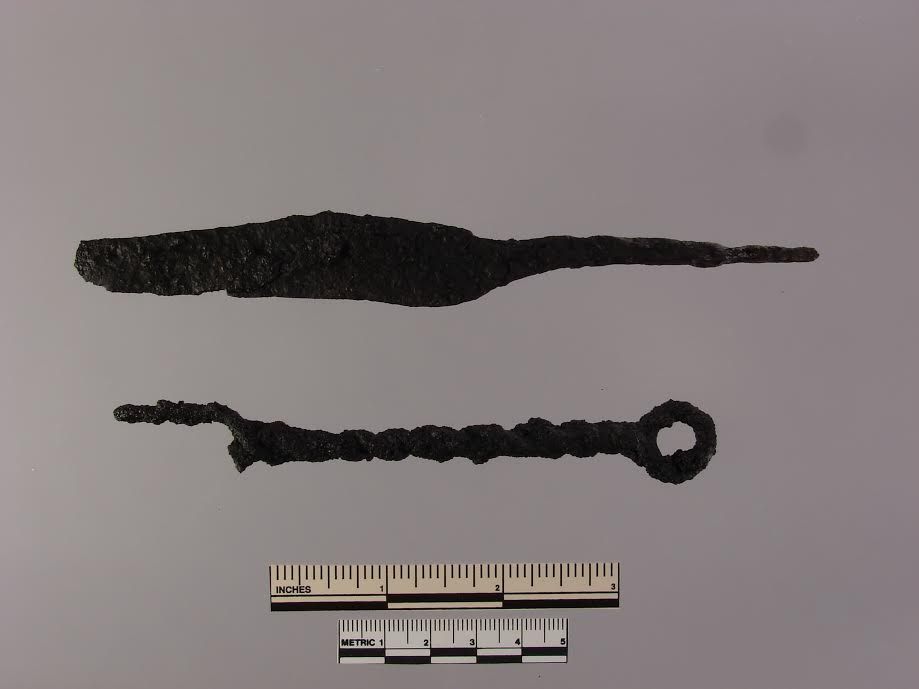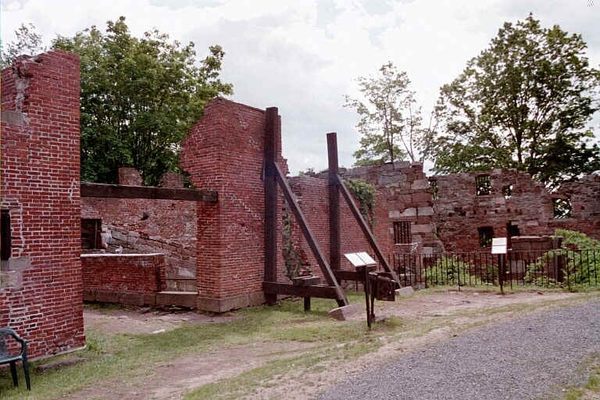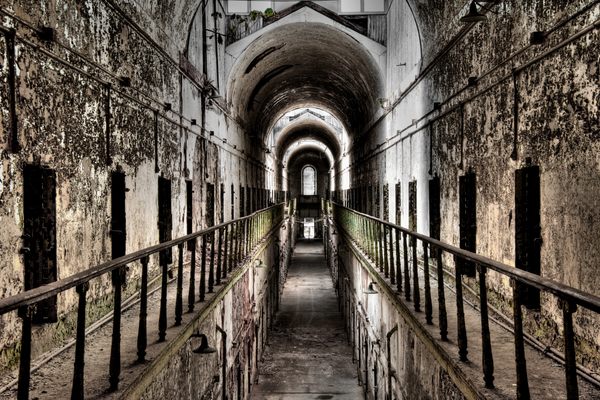Starving Felons, and Other Lessons from Prison Archaeology

The view from an observation tower built to accommodate tourists who flocked to Old Newgate. (Photo: Connecticut State Historic Preservation Office)
William Stuart didn’t really mind sleeping 50 feet underground in a dank abandoned mine or being in close quarters with felons—the ticks and fleas were fewer in the subterranean world and the temperature stayed fairly cool and constant. But what he hated about life at Old Newgate Prison was the food, or lack thereof.
Stuart was a relentless con man and counterfeiter who wreaked havoc throughout New England and Canada before landing at Old Newgate in East Granby, Connecticut. When he arrived in shackles in 1820, he expected to be served coarse cuts of beef and bread with the texture of flint. But he didn’t think he deserved such small portions. While he watched the prison keeper run a side-business selling fat skimmed off the inmates’ meals, Stuart claimed he wasn’t given a third of the food he needed to survive the day.
Though Stuart’s roguish autobiography, published in 1854, offers a rare firsthand account of what life was like inside Old Newgate, he is an imperfect, if entertaining, narrator. But new evidence found at the site of Old Newgate suggests that Stuart wasn’t embellishing how miserable it was to dine there 200 years ago. Archaeologists recently discovered animal bones bashed for every last scrap of nutrition and a crude fork and knife made out of nails—signs that the prisoners weren’t given enough food or even any utensils to eat it with.
“It’s too bad Paul Newman isn’t alive anymore,” says Karin Peterson, museum director of Connecticut’s State Historic Preservation Office. “I could just see Stuart being played in a movie by someone like Newman.”
“Stuart is clearly a character and you have to wonder, was he playing some of this up?” says Sarah Sportman, a zooarchaeologist. “And I don’t know, I’m really starting to think that his account might have been more accurate”—at least with regard to the terrible food situation. Sportman works with Archaeological and Historical Services, a Connecticut-based company that was contracted to excavate at Old Newgate. The prison, which was shut down in 1827, is now a state-owned museum, but it has been closed to the public since 2009 after the walls of the guardhouse were found to be cracking and near collapse.

The cover from “Sketches of the life of William Stuart: The First and Most Celebrated Counterfeiter of Connecticut” (Photo: Public Domain/Google Digitized)
The ongoing restoration effort has offered archaeologists a rare chance to explore layers of dirt on the property that haven’t been touched in nearly 200 years. In 2013, Sportman and her colleagues excavated test pits and trenches in a terrace just west of the guardhouse to salvage whatever archaeological remains might be hidden in areas that will be disturbed by the reconstruction.
“We have found more in the little test pits that they did than we have found ever before,” Peterson said. Most of the material comes from a layer of trash that dates back to the period between 1790, when the brick guardhouse was first built, and 1819, when the building was expanded. There are bits of broken pottery and glass, but the animal bones—primarily from beef, pork and sheep—are most interesting Sportman because many of them look like they’ve been smashed open and processed again and again.
“It’s something you tend to see in starvation contexts,” Sportman says. “You eat the meat and then you bash the bones open to get the marrow and then you boil them to get all the grease out. You can just keep going back to try to get every little bit of nutrition that you can.” These so-called signatures of starvation were recently identified on animal bones found at an 1846 campsite of the ill-fated Donner Party and a 1870s Chinese mining camp in western Montana called China Gulch—two places where there’s historical evidence that people were starving.
Old Newgate, the name nonewithstanding, was America’s first state prison when it opened in the early 1770s at the site of the failed Simsbury copper mines. The underground tunnels and shafts were repurposed to house prisoners, and the name Newgate was presumably intended to stir up forbidding associations with the notorious Newgate prison in London. But Connecticut’s version quickly became something of an embarrassment. The first prisoner, John Hinson, arrived on December 22, 1773, and escaped just 18 days later with the help of a rope tossed down the mineshaft by “a woman to whom he was paying his addresses.” It was the first of dozens of jailbreaks. A burglar named Richard Steele pulled off a record three escapes. A guardhouse was eventually built directly over the entrance to the mine. Inmates burned it down on three separate occasions before the state finally decided to construct a sturdier guardhouse out of brick in 1790.
 Archaeologists excavated shovel test pits on the terrace west of the guardhouse. The ruins of a prison building that was constructed around 1824 can be seen in the background. (Photo: Sarah Sportman/AHS)
Archaeologists excavated shovel test pits on the terrace west of the guardhouse. The ruins of a prison building that was constructed around 1824 can be seen in the background. (Photo: Sarah Sportman/AHS)
Stuart never managed to escape himself, but he took particular delight in tormenting his prison keeper Captain Elam Tuller. Though he dressed in respectable military garb complete with epaulets on his shoulders and a sword on his side, Tuller was a brute, a despot and “an unfeeling Nero” in Stuart’s estimation. The two men butt heads constantly. When Stuart was caught making counterfeit coins using melted down pewter buttons and a mold made out of soap, he told Tuller, “I was sent here for counterfeiting, and I shall lose my skill unless I do a little at the business,” to which Tuller replied, “Stuart, I believe that you are the devil.”
Stuart’s chief gripe with Tuller was that he provided the prisoners with grossly insufficient food. At least according to Stuart, Tuller was $500 in debt before he became prison keeper, and after being in charge of Old Newgate for six years, he had not only paid off his debts, but collected another $12,000 from the state that he was supposed to spend on the prisoners. He bought cattle, had it butchered and took the best cuts for himself. He ordered the cook to scrape “every particle of grease” from the pots of the inmates’ food and was able to sell 3,000 lbs. of tallow yearly. “I and my fellow prisoners have picked the bones all bare for a meal, and often it would not be two tablespoons-full,” Stuart wrote.
The prisoners at Old Newgate typically climbed out of the mines at 4 a.m. to make liquor barrels, nails and other goods. When Tuller demanded that Stuart and his fellow prisoners start making three barrels instead of two a day, Stuart pushed back and refused to work at all, arguing that he wasn’t given enough food. “Tuller, we are half starved, and have not strength to work,” Stuart claims he told the prison keeper. “The government are not aware that the prisoners are dying with starvation and you are getting rich from us.”
As punishment, Stuart was locked up in a dungeon for 12 days, given only bread and water. He was so enraged afterwards that he tried to arrange a revolt. He thought 70 fellow prisoners had his back, but only three joined him when it came time for the insurrection. Stuart was seriously wounded in his battle against the guards—he was shot in the groin and stabbed several times—but he eventually exaggerated his injuries enough to bid for his release from prison in 1825. The day he was discharged, Stuart tossed his crutches and went straight to the nearest tavern. “Had I known that you could move about so easily, I would have kept you here as long as grass grows and water runs,” Tuller told him.
 A knife and fork crudely fashioned out of nail rod were recovered during the 2013 excavations around Old Newgate’s guardhouse. (Photo: Sarah Sportman/AHS)
A knife and fork crudely fashioned out of nail rod were recovered during the 2013 excavations around Old Newgate’s guardhouse. (Photo: Sarah Sportman/AHS)
Stuart wasn’t the only one writing at the time about starvation conditions. The English author Edward Augustus Kendall, who published several volumes about his travels through the northern United States in the early 19th century, paid a visit to Old Newgate and was fairly horrified at what he saw. The prisoners didn’t get a break from making nails to eat; Kendall watched as the inmates were tossed their food while chained to their workstations. Pickled pork was “thrown upon the floor and left to be washed and boiled in the water used for cooling the iron wrought at the forges.”
Utensils gathered from Old Newgate support that vision. The archaeologists also found a very primitive fork and knife made from nail rod, the raw material the prisoners used in the workshop. “I can just see a prisoner who wants to live more like a civilized human being taking what’s at hand and fashioning a crude fork,” Peterson says. The prisoner’s alternative would have been eating with his hands.
Peterson says archaeologists rarely have the funding to dig at historic sites in the United States purely for the pursuit of knowledge. The current archaeological work at Old Newgate is entirely dictated by the restoration project; Sportman and her colleagues are only digging up the historic areas that have to, under preservation laws, be excavated before they’re bulldozed and covered up with new support beams and other building materials.
“We can’t come up with a dream plan and say we want to dig here and here and here,” Sportman said. There is not too much archaeological literature about the diet at prisons from this time period, Sportman said. Still, whatever remains are found at Old Newgate could one day prove whether the conditions at the prison were really that unique.
 The prison yard at Old Newgate today. Beyond the gate is the roof of Luke Viets’ tavern, which benefited greatly from the prison. It got business from guards, tourists such as Edward Kendall and even prisoners with a bit of cash. Stuart spent ten dollars of counterfeited money there before getting caught. (Photo: Connecticut State Historic Preservation Office)
The prison yard at Old Newgate today. Beyond the gate is the roof of Luke Viets’ tavern, which benefited greatly from the prison. It got business from guards, tourists such as Edward Kendall and even prisoners with a bit of cash. Stuart spent ten dollars of counterfeited money there before getting caught. (Photo: Connecticut State Historic Preservation Office)
 Inside the prison ruins. (Photo: Heather Katsoulis/Flickr)
Inside the prison ruins. (Photo: Heather Katsoulis/Flickr)
“Newgate represents a shift in how you treat criminals, how you treat people convicted of bad crimes,” says Peterson. “Historically, especially in New England, people were punished physically. They could fine you. They could put you in stocks. Instead of giving you a scarlet ‘A’ on your clothes, they would literally brand your forehead. They would cut off the top of your ear. And then they would let you go. The idea of incarcerating people to pay their debt to society is an idea coming out of the Enlightenment Age of Europe, and Connecticut decides to try this.”
More excavations may take place this summer at Old Newgate. Peterson says she is personally most excited to find out what’s under the stones that line the floor of the 1819 addition to the guardhouse. Archaeologists already pried up one of the blocks to get an idea of the condition of the soil sealed underneath, and they discovered something that, for Peterson, was better than King Tut’s gold: a diminutive playing die.
“Stuart talks about gaming,” Peterson said. “We can’t prove that this was owned and made by a prisoner who lost it between a crack in the floor—and probably was very annoyed because he couldn’t win that roll of craps because his die disappeared—but it has to be. It’s miniature. It’s the type of thing that you could easily conceal on your body if they did a body search.”
The die, with little carbon-colored dots, is hand-carved out of animal bone—perhaps hinting that bones at Old Newgate could have another life after they were exhausted for all of their nutritional worth.
“What could bring out the life of the prisoners more vividly?” Peterson said.








Follow us on Twitter to get the latest on the world's hidden wonders.
Like us on Facebook to get the latest on the world's hidden wonders.
Follow us on Twitter Like us on Facebook